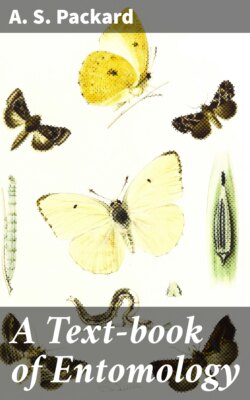Читать книгу A Text-book of Entomology - A. S. Packard - Страница 3
На сайте Литреса книга снята с продажи.
PREFACE
ОглавлениеTable of Contents
In preparing this book the author had in mind the wants both of the student and the teacher. For the student’s use the more difficult portions, particularly that on the embryology, may be omitted. The work has grown in part out of the writer’s experience in class work.
In instructing small classes in the anatomy and metamorphoses of insects, it was strongly felt that the mere dissection and drawing of a few types, comprising some of our common insects, were by no means sufficient for broad, thorough work. Plainly enough the laboratory work is all important, being rigidly disciplinary in its methods, and affording the foundation for any farther work. But to this should be added frequent explanations or formal lectures, and the student should be required to do collateral reading in some general work on structural and developmental entomology. With this aim in view, the present work has been prepared.
It might be said in explanation of the plan of this book, that the students having previously taken a lecture course in the zoölogy of the invertebrates, were first instructed in the facts and conclusions bearing on the relations of insects to other Arthropoda, and more especially the anatomy of Peripatus, of the Myriopoda, and of Scolopendrella. Then the structure of Campodea, Machilis, and Lepisma was described, after which a few types of winged insects, beginning with the locust and ending with the bee, were drawn and dissected; the nymph of the locust, and the larva and pupa of a moth and of a wasp and bee being drawn and examined. Had time permitted, an outline of the embryology and of the internal changes in flies during their metamorphoses would have been added.
This book gives, of course with much greater fulness and detail for reference and collateral reading, what we roughly outlined in our class work. The aim has been to afford a broad foundation for future more special work by any one who may want to carry on the study of some group of insects, or to extend in any special direction our present knowledge of insect morphology and growth.
Many of our entomologists begin their studies without any previous knowledge of the structure of animals, taking it up as an amusement. They may be mere collectors and satisfied simply to know the name of their captures, but it is hoped that with this book in their hands they may be led to desire farther information regarding what has already been done on the structure and mode of growth of the common insects. For practical details as to how to dissect, to make microscopic slides, and to mount and preserve insects generally, they are referred to the author’s “Entomology for Beginners.”
It may also be acknowledged that even in our best and latest general treatises on zoölogy, or comparative anatomy, or morphology, the portion related to insects is scarcely so thoroughly done as those parts devoted to other phyla, that of Lang, however, his invaluable Comparative Anatomy, being an exception. On this account, therefore, it is hoped that this hiatus in our literature may be in a degree filled.
The author has made free use of the excellent article “Insecta” of Newport, of Lang’s comprehensive summary in his most useful Text-book of Comparative Anatomy, of Graber’s excellent Die Insecten, of Miall and Denny’s The Structure and Life-History of the Cockroach, and of Sharp’s Insecta. Kolbe’s Einführung has been most helpful. But besides these helps, liberal use has been made of the very numerous memoirs and monographic articles which adorn our entomological literature. The account of the embryology of insects is based on Korschelt and Heider’s elaborate work, Lehrbuch der Vergleichenden Entwicklungsgeschichte der Wirbellosen Thiere, the illustrations of this portion being mainly taken from it, through the Messrs. Swan Sonnenschein & Co., London.
Professor H. S. Pratt has kindly read over the manuscript and also the proofs of the portion on embryology and metamorphoses, and the author is happy to acknowledge the essential service he has rendered.
The bibliographical lists are arranged by dates, so as to give an idea of the historical development of each subject. The aim has been to make these lists tolerably complete and to include the earliest, almost forgotten works and articles as well as the most recent.
Much care has been taken to give due credit either to the original sources from which the illustrations are copied, or to the artist; about ninety of the simpler figures were drawn by the author, many of them for this work. For the use of certain figures acknowledgments are due to the Boston Society of Natural History, to the Division of Entomology, U. S. Department of Agriculture, through the kind offices of Mr. L. O. Howard, and to the Illinois State Laboratory of Natural History, through Professor S. A. Forbes and Mr. C. A. Hart. Professor W. M. Wheeler, of the University of Chicago, has kindly loaned for reproduction several of his original drawings published in the Journal of Morphology. A number are reproduced from figures in the reports of the United States Entomological Commission.
Providence, R. I.,
March 4, 1898.
